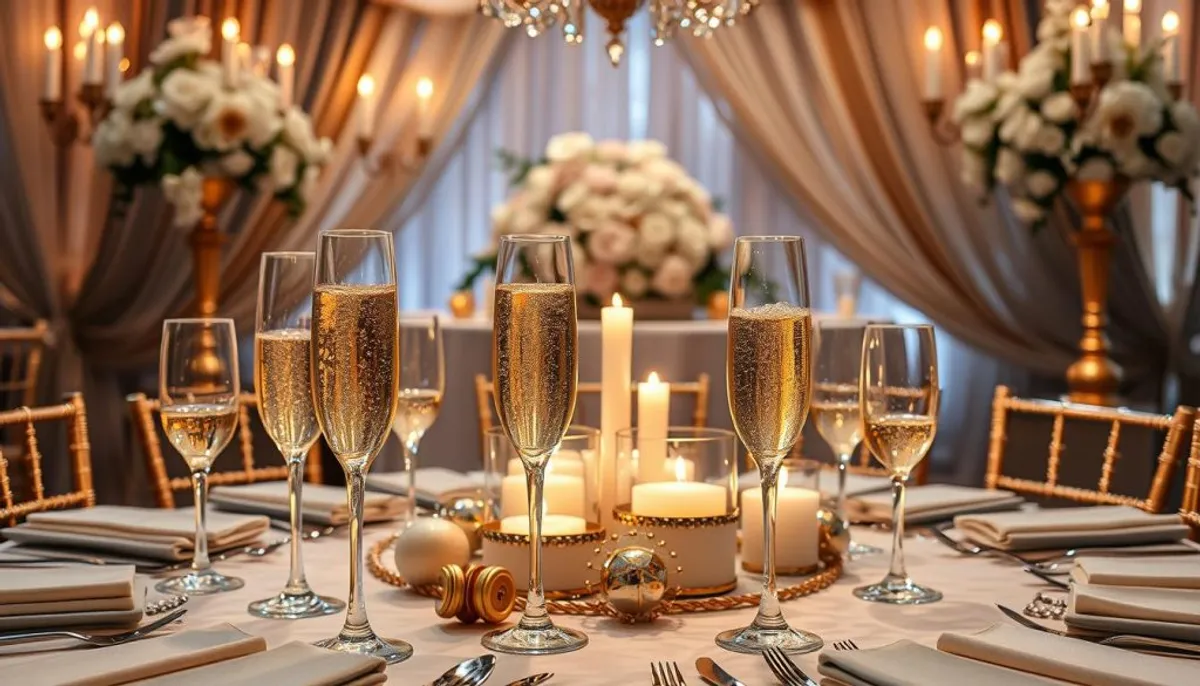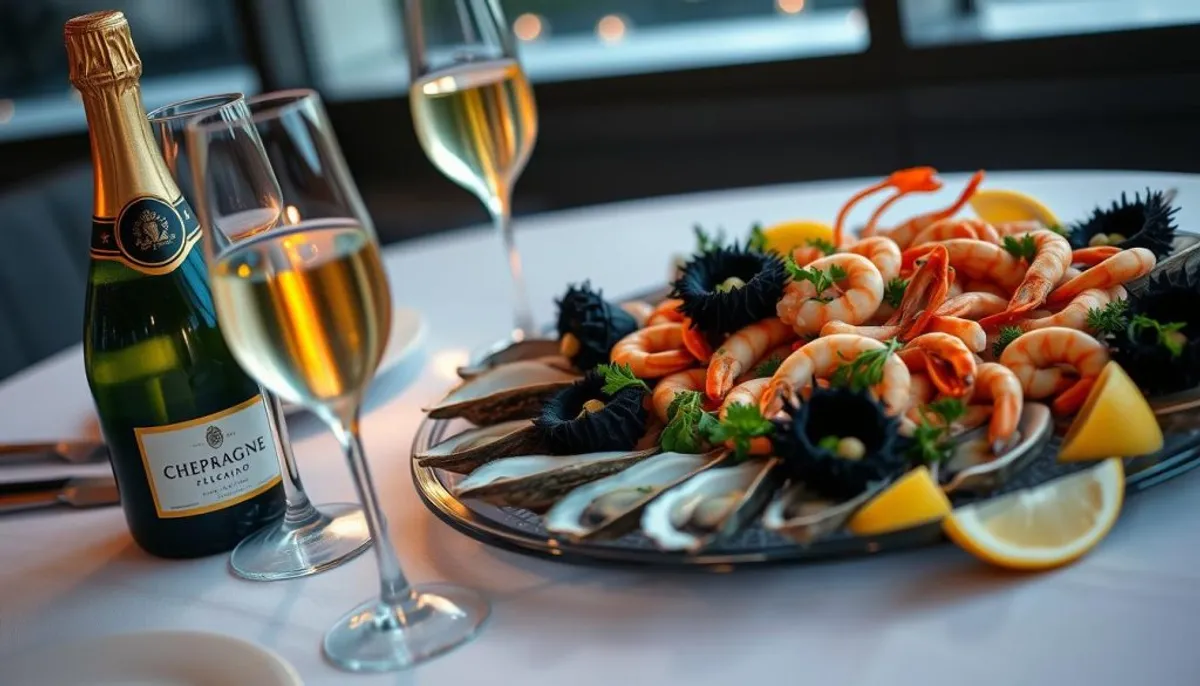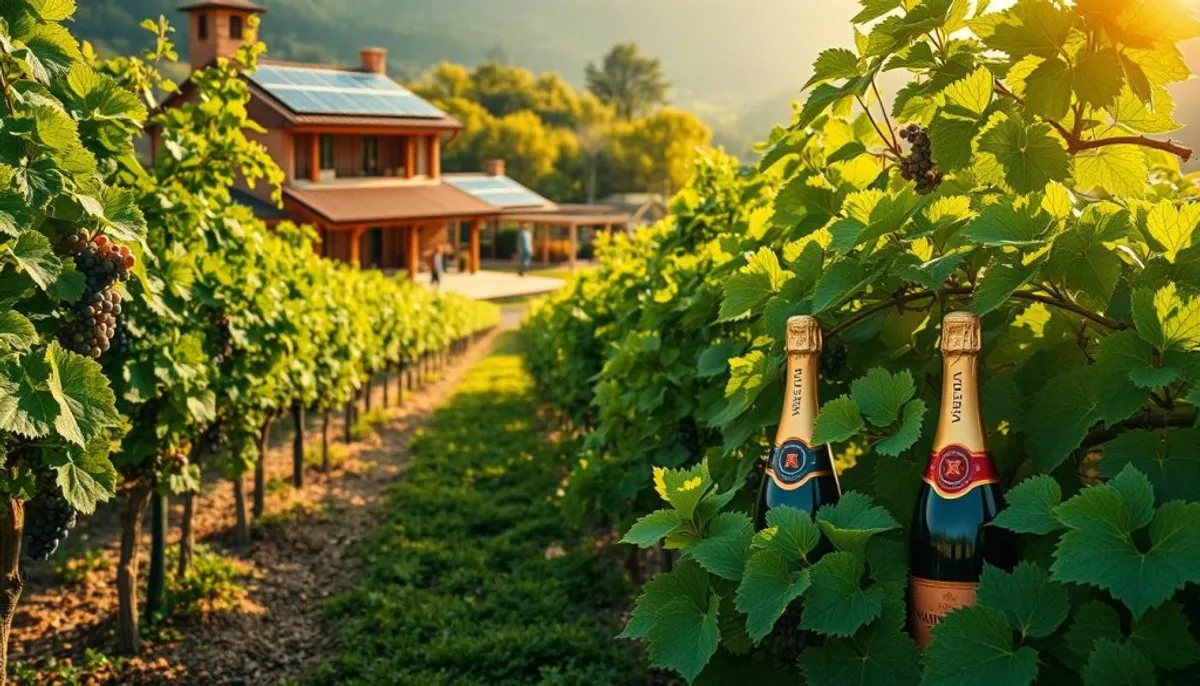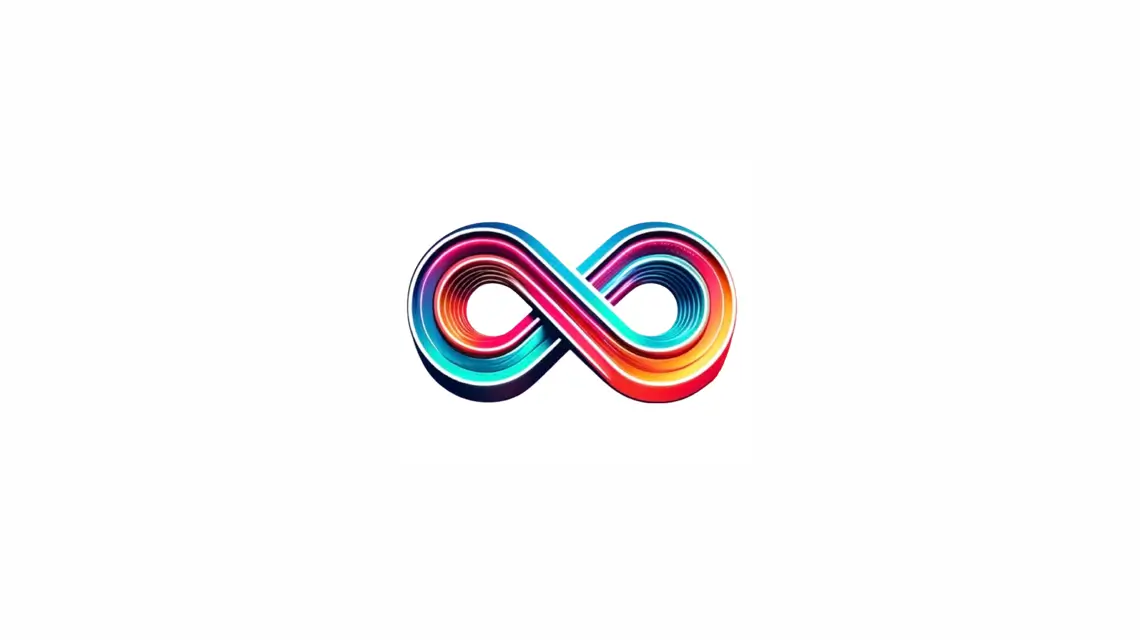Pop the cork and let the luxury champagne flow! This premium sparkling wine has become the go-to drink for special moments. From weddings to New Year’s Eve, high-end bubbles add sparkle to any event. French Champagne stands out as the ultimate celebratory drink, loved for its festive nature and fancy appeal.
Champagne comes in many styles and price points. Brands like Moët & Chandon, Veuve Clicquot, and Dom Pérignon are known for their top-notch quality. These names bring prestige to any glass, making them perfect for marking milestones or simply enjoying life’s little luxuries.

What sets luxury champagne apart? It’s not just the bubbles – it’s the craft behind each bottle. Made in the Champagne region of France, these wines follow strict rules. The result? A drink that’s both easy to sip and great with food. Whether you’re toasting at a fancy dinner or relaxing at home, a glass of champagne adds a touch of class.
Key Takeaways
- Luxury champagne is the top choice for celebrations
- French Champagne is known for its prestige and quality
- Top brands include Moët & Chandon, Veuve Clicquot, and Dom Pérignon
- Champagne comes in various styles to suit different tastes
- The Champagne region in France is the exclusive source of true champagne
- For those seeking something special, exclusive champagne collections offer a unique selection.
- Champagne pairs well with many foods, making it versatile for events
Understanding the World of Luxe Champagne
Luxe champagne distinguishes itself within the realm of sparkling wines. Its distinctiveness arises from rigorous production standards and a particular geographical origin. We will examine the factors that contribute to champagne’s uniqueness.
What Makes Champagne Different from Sparkling Wine
Champagne’s uniqueness is rooted in its origin and the meticulous production process. Only the Champagne region in northeastern France can claim to produce true champagne. The méthode champenoise, a cornerstone of champagne production, entails a second fermentation within the bottle. This prolonged fermentation, lasting at least 15 months, is responsible for champagne’s distinctive flavor and effervescence.
The Prestigious Champagne Region of France
The Champagne region’s cool climate and the presence of limestone-rich soil are conducive to growing champagne grapes. This terroir imparts unique characteristics to the wine. French law enforces strict regulations on champagne production, ensuring its prestigious status.
The Art of Champagne Making
Champagne making is an intricate art form. Winemakers meticulously blend various grape varieties and vintages to achieve consistent flavors. The majority of champagne is non-vintage, a blend of wines from multiple years. Vintage champagnes, crafted from a single year’s harvest, require a minimum of three years of aging. Prestige cuvées, the pinnacle of a house’s offerings, are produced only in the most exceptional years.
| Champagne Type | Description | Aging Time |
|---|---|---|
| Non-Vintage | Blend of multiple years | Minimum 15 months |
| Vintage | Single year harvest | Minimum 3 years |
| Prestige Cuvée | Finest quality, exceptional vintages | Varies by house |
Heritage and History of Elite Champagne Houses
The champagne history is a tapestry woven with threads of innovation and luxury. For centuries, prestigious champagne houses have sculpted the industry, leaving an enduring impact on the realm of fine wines. Today, many of these houses offer exclusive champagne collections that showcase their finest offerings and craftsmanship.
The Legacy of Dom Pérignon
Dom Pérignon, a Benedictine monk, was instrumental in champagne’s evolution. His pioneering methods established the groundwork for contemporary champagne production. The Dom Pérignon legacy is perpetuated through Moët & Chandon’s esteemed cuvée, a tribute to his name.
Evolution of Champagne Through Centuries
Champagne’s journey is characterized by a relentless pursuit of excellence. In the late 19th century, Raoul Chandon de Briailles of Moët founded the first viniculture research laboratory. This initiative saved Champagne vineyards from phylloxera, embodying the commitment to quality that defines elite champagne houses.
Royal Connections and Prestigious Patronage
Royal champagne has long been synonymous with opulence. The bond between Napoleon Bonaparte and Jean-Rémy Moët illustrates the profound relationship between royalty and champagne houses. The coronation of French kings in Reims, the epicenter of Champagne, solidified this esteemed connection.
| Champagne House | Founding Year | Notable Feature |
|---|---|---|
| Ruinart | 1729 | Oldest established Champagne house |
| Moët & Chandon | 1743 | 28km of underground cellars |
| Veuve Clicquot | 1772 | Invented the riddling technique |
These venerable champagne houses continue to honor tradition while pioneering new frontiers. They ensure champagne’s status as a beacon of celebration and elegance.
Top Luxury Champagne Brands and Their Signatures
The realm of premium champagne brands is replete with luxury bubbly that captivates the senses. These high-end sparkling wines originate from esteemed champagne houses, each boasting its own distinct style and rich history.
Moët & Chandon, a vanguard among luxury champagne brands, presents its Imperial at $50. This iconic house oversees 1,190 hectares of vineyards, with half classified as Grand Cru and a quarter as Premier Cru. Veuve Clicquot, celebrated for its Yellow Label at $70, achieved a remarkable 647,000 9-liter cases in the US in 2021.
Dom Pérignon, emblematic of high-end sparkling wine, ages its Brut and rosé for approximately 7 years. For aficionados, their P2 Plénitude Brut, priced at $550, embodies the zenith of luxury. Krug’s Grand Cuvée exemplifies the art of blending, combining over 120 wines from more than a decade to forge its signature style.
| Brand | Signature Cuvée | Price |
|---|---|---|
| Louis Roederer | Cristal 2015 | $330 |
| Bollinger | Brut Special Cuvee | $80 |
| Taittinger | Brut Champagne | $70 |
These champagne houses persist in their pursuit of innovation, with Veuve Clicquot crafting 3,200 limited-edition Yellowbeam Ostrich bottles. Louis Roederer’s Cristal 2015 presents a deep yellow hue, accompanied by notes of almond blossom and lemon curd, illustrating the craftsmanship behind these premium champagne brands.
Prestige Cuvées and Limited Editions
Champagne aficionados are drawn to prestige cuvées and rare releases for their unmatched quality and exclusivity. These vintage champagnes embody the zenith of winemaking, commanding high prices and sparking collector interest.
Dom Pérignon Vintage Collections
Dom Pérignon, a symbol of opulence, produces champagnes of unmatched quality. Since its debut in 1921, Dom Pérignon has focused solely on vintage champagnes. Each vintage is released in three stages: the first after nine years, the second (P2) after 12-15 years, and the third (P3) after 25 years. This extended aging process imbues the champagne with complex flavors and aromas, making it a favorite among connoisseurs. Additionally, their exclusive champagne collections offer a unique opportunity for collectors and enthusiasts to experience rare selections.
Krug Grande Cuvée Excellence
Krug Grande Cuvée is celebrated for its meticulous blending process. This prestige cuvée is crafted from over 120 wines from various vintages, resulting in a champagne of remarkable depth and character. Krug’s dedication to excellence is reflected in their limited production, ensuring each bottle meets their stringent standards.
Louis Roederer Cristal Prestige
Cristal, first created in 1876 for Tsar Alexander II, is one of the most coveted limited edition champagnes. Its distinctive clear bottle and golden hue epitomize the pinnacle of Louis Roederer’s champagne expertise. The champagne’s rarity and historical significance make it a highly sought-after addition to any collection.
| Prestige Cuvée | Unique Feature | Price Range |
|---|---|---|
| Dom Pérignon Vintage | Three-stage release process | $180 – $300+ |
| Krug Grande Cuvée | Blend of 120+ wines | $170 – $250 |
| Louis Roederer Cristal | Clear bottle, golden hue | $250 – $400+ |
The Art of Serving Luxe Champagne
Mastering champagne etiquette is essential for an elevated tasting experience. The art of serving luxe champagne hinges on meticulous attention to detail. Achieving the correct serving temperature is paramount. Chill your bottle to 45-50°F (7-10°C) for the optimal flavor release. This temperature range ensures the delicate bubbles are preserved while allowing the aromas to flourish.
The selection of champagne glassware is equally critical. While flutes remain a classic choice, tulip-shaped glasses are increasingly favored. These glasses concentrate the bubbles and aromas, significantly enhancing the sensory experience. When opening champagne, aim for elegance and control. Hold the bottle at a 45-degree angle and gently twist the bottle, not the cork.
| Aspect | Recommendation |
|---|---|
| Serving Temperature | 45-50°F (7-10°C) |
| Glassware | Flutes or Tulip-shaped |
| Opening Technique | 45-degree angle, twist bottle |
| Pouring | Tilt glass, pour slowly |
Pour champagne slowly, tilting the glass to preserve bubbles. Fill to about two-thirds, allowing space for aromas to gather. Remember, serving luxe champagne is an art that enhances celebrations. With these tips, you’ll serve champagne like a pro, impressing guests at any event.
Pairing Elite Champagne with Fine Cuisine
Champagne food pairings elevate any dining experience. The versatility of luxe champagne allows for creative gourmet champagne matches across various cuisines and flavors. Let’s explore some exquisite combinations that will tantalize your taste buds.
Seafood and Champagne Combinations
Champagne and seafood make a classic pairing. The crisp acidity of champagne complements the delicate flavors of oysters and caviar. Belaire Brut Gold, with its notes of lemon and stone fruits, pairs beautifully with seafood dishes and light salads.

Dessert Pairings for Sweet Champagne
Dessert champagne offers a delightful end to any meal. Belaire Luxe Rosé, with hints of wild berry and vanilla, pairs perfectly with chocolate desserts and soft cheeses. For a unique twist, try Belaire Bleu with its tropical fruit aromas alongside a mango sorbet. Additionally, consider the appeal of stylish champagne packaging, which enhances the overall experience and presentation of your dessert champagne.
Canapés and Champagne Matching
Light canapés and hors d’oeuvres are ideal companions for brut champagnes. Belaire Rosé, featuring aromas of strawberries and cherries, complements grilled meats and spicy dishes. For a more refined pairing, match Belaire Luxe with roasted chicken or creamy cheeses.
| Champagne | Flavor Profile | Food Pairing |
|---|---|---|
| Belaire Brut Gold | Lemon, stone fruits, brioche | Seafood, oysters, light salads |
| Belaire Rosé | Strawberries, blackcurrants, cherries | Grilled meats, spicy dishes, fresh fruits |
| Belaire Luxe | Honey, pear, mango | Roasted chicken, creamy cheeses, rich desserts |
| Belaire Luxe Rosé | Wild berry, vanilla, toast | Chocolate desserts, foie gras, soft cheeses |
Investment Value of Rare Champagnes
Rare vintage bubbly has emerged as a lucrative champagne investment opportunity. Wine auctions showcase the potential of collectible champagne, with some bottles fetching astronomical prices. For instance, a Salon Le Mesnil Blanc de Blancs 1990 sold for €25,000 at a Sotheby’s auction, highlighting the incredible value of certain vintages.
Investing in champagne requires careful consideration. Vintage champagnes, which must age for at least 36 months, often command higher prices than non-vintage varieties. Prestige cuvées from renowned houses like Dom Pérignon, Krug, and Louis Roederer’s Cristal are highly sought after by collectors.
Interestingly, lesser-known vintages can offer excellent value. Chardonnay-based champagnes from years like 2006, 2007, 2010, or 2017 may be smart investments due to their resilience to vintage conditions. Grower champagnes, with their limited production, including limited edition champagne, can also be attractive options for investors.
| Champagne | Auction Price |
|---|---|
| Salon Le Mesnil Blanc de Blancs 1990 | €25,000 |
| Dom Pérignon P3 1966 | €23,750 |
| Krug Collection 1985 | €21,250 |
When investing in rare champagnes, focus on provenance, original packaging, and proper storage. These factors significantly impact a bottle’s value and potential appreciation over time. With fine wine prices rising 149% in the last decade, champagne investment continues to be an enticing option for collectors and investors alike.
Celebrating Special Occasions with Premium Bubbles
Premium champagne elevates life’s most treasured moments with its elegance. It’s essential for wedding ceremonies and corporate events, turning them into memorable experiences. The right champagne can transform an event, making it unforgettable.
Wedding Champagne Selection
Choosing the perfect wedding bubbly is crucial for setting the tone of your special day. Moët & Chandon and Veuve Clicquot are popular choices, known for their crisp flavors and elegant bottles. For a luxurious touch, consider a vintage Dom Pérignon, with its complex notes and prestigious reputation.
Corporate Event Choices
Corporate event drinks should reflect the company’s values and impress clients. Krug Grande Cuvée, with its rich blend of over 120 wines, is an excellent choice for high-profile gatherings. Schramsberg Vineyards offers impressive quality at a lower price point, making it a budget-friendly option.
Anniversary Celebrations
Anniversary toasts call for something extraordinary. Louis Roederer Cristal, with its iconic clear bottle and exquisite taste, is perfect for milestone years. For a unique twist, consider a limited edition champagne or a Blanc de Blancs champagne, made entirely from Chardonnay grapes, offering a crisp and elegant flavor profile.
| Occasion | Recommended Champagne | Price Range |
|---|---|---|
| Wedding | Moët & Chandon Imperial | $50-$60 |
| Corporate Event | Krug Grande Cuvée | $180-$200 |
| Anniversary | Louis Roederer Cristal | $250-$300 |
The key to selecting the perfect celebration champagne is considering your guests’ preferences and the event’s significance. Whether it’s a wedding, corporate gathering, or anniversary, the right bubbly will elevate your special occasion to new heights.
Sustainable Luxury in Modern Champagne Production
The champagne industry is now embracing sustainable practices, with a goal to cut carbon emissions by 25% by 2025. Estates are transitioning vineyards to sustainable agriculture, emphasizing organic champagne and biodynamic viticulture. This shift is crucial for the future of the industry.
Eco-friendly winemaking is gaining prominence. Champagne houses are integrating solar panels, electric car charging stations, and lighter bottles into their operations. Some producers are adopting regenerative agricultural methods, ensuring sustainable champagne production.

Maison Ruinart, founded 290 years ago, introduced its Dom Ruinart 2010 vintage in innovative ‘Chalk Wrap’ packaging in 2022. This ‘Second Skin’ solution, developed by James Cropper’s Moulded Fibre division, is fully recyclable and 9 times lighter than previous packaging. It significantly reduces carbon footprint by 60%.
| Feature | Benefit |
|---|---|
| 100% recyclable packaging | Reduces waste |
| 91% water efficiency | Conserves resources |
| FSC-certified wood fibers | Supports sustainable forestry |
| Chemical-free white color | Promotes eco-friendly design |
Sustainable luxury champagne prices range from $44 to $279, catering to eco-conscious consumers. This transition ensures that luxury champagne production respects environmental concerns while preserving quality and prestige.
Conclusion
The luxury champagne experience is a unique blend of history, craftsmanship, and sensory delight. Originating from the prestigious Champagne region of France, it has become the elite choice for discerning consumers globally. The premium bubbly culture evolves, emphasizing quality, sustainability, and innovation. For those looking to elevate their gatherings, a brunch champagne guide can provide insights into the best pairings and selections.
Champagne appreciation transcends mere consumption. It involves grasping the intricate production process, from initial fermentation lasting 1-2 weeks to the aging period of at least 15 months for non-vintage champagnes. The “remuage” process and the addition of “liqueur d’expédition” are critical, enhancing the final product’s quality and taste.
While luxury champagne remains the pinnacle, other sparkling wines are gaining recognition. Luc Belaire Brut Sparkling Wine from Burgundy, France, priced at $32.99, presents a sophisticated alternative. With its 11.5% ABV and flavor notes of grapefruit, apricot, and peach, it complements seafood and light appetizers, appealing to those seeking well-balanced sparkling wines for various occasions.
As we raise our glasses to celebrate life’s special moments, let’s toast to champagne’s enduring allure. Its rich heritage, meticulous craftsmanship, and ability to elevate any occasion ensure its continued allure for wine enthusiasts and connoisseurs for generations to come.
RelatedRelated articles



